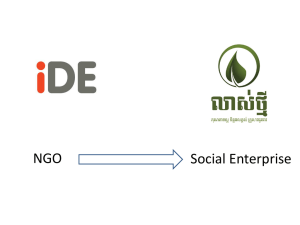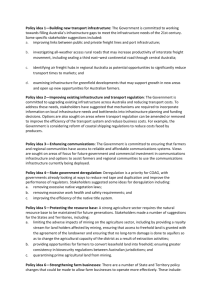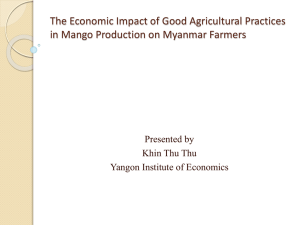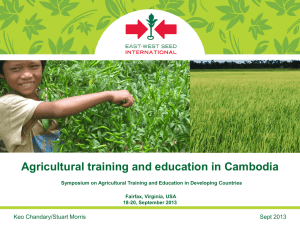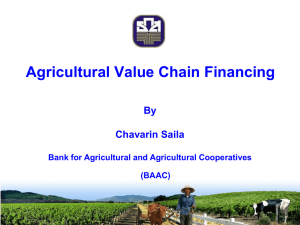Behavioral and Material Determinants of Production Relations in
advertisement
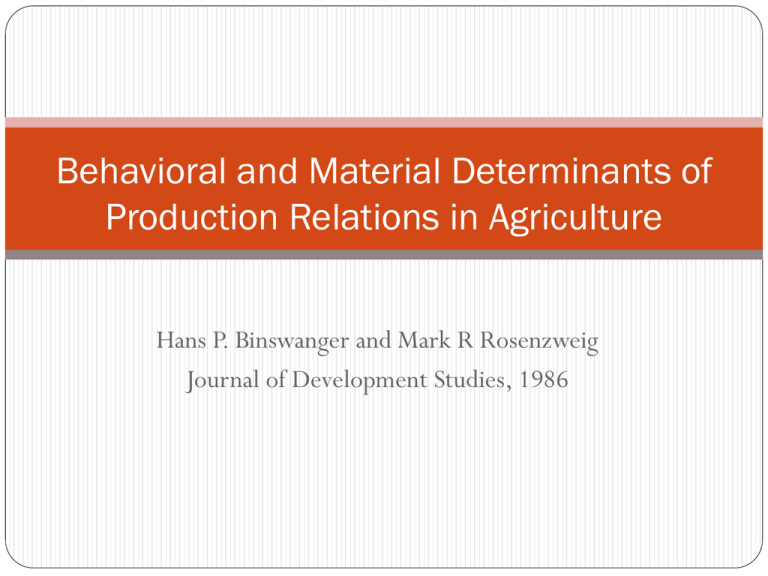
Behavioral and Material Determinants of Production Relations in Agriculture Hans P. Binswanger and Mark R Rosenzweig Journal of Development Studies, 1986 Objectives Analyze the institutions governing production and exchange of output and primary factors of production in rural areas Incorporate risk and information constraints, together with the material attributes of agricultural production and production factors Analyze barriers to markets for credit and insurance, and land sales markets Analyze the causes of diseconomies of scale in agriculture, and the reasons for the existence of plantation agriculture Two simultaneous problems of agricultural households Achieve high levels of incomes, consumption and leisure (one period problem) To even out consumption in the face of risk, and to avoid disasters (over time problem) In economics we separate these problems by assuming that we have inter-temporal markets for risk and credit (Arrow and Debrew) But these are generally non-existent in agriculture or highly imperfect Therefore the inter-temporal functions have to be solved in output and factor markets, by building reserves, or via social relations Initial Assumptions Individuals face many risks Information is costly Individuals are self interested, they value consumption and dislike effort Individuals are risk averse Initial consequences Asymmetric information in labor, credit or insurance markets Incentives problems: moral hazard or adverse selection – leads to share cropping in rental markets Imperfect enforcement of property rights – eg theft Desirability of broad spectrum of insurance Collateral requirement for larger loans Consequences for credit market Credit rationing for borrowers without collateral (even at higher interest rates) If there are no insurance markets, credit becomes and insurance substitute Collateral assets must be appropriable, not carry asset-specific risks, returns must accrue to the borrower Collateral conditions for different assets Basic agricultural assumptions Heterogeneity of land and people Spatial dispersion and high transport and travel costs High cost of acquiring information Leads to aggravation of asymmetric information Seasonality of production, and synchronic timing of operations Many sources of risk: from weather and yield, price, timing uncertainties, life cycle risks Covariance of risks in small agricultural areas! Absence of crop insurance 1. High travel costs makes sales and cost of damage assessment expensive, and increase moral hazard Potential solutions: 2. Insure only catastrophic events such as hail or floods which are easy to observe: specific risk insurance widely available Index-based insurance that insures a weather event, not the yield risk (has many problems) High covariance of risk All farmers experience loss in the same year Leading to bankruptcy of the insurer Potential solutions: Combine farmers from different regions or different countries but this solution aggravates problems 1 The combination of problems 1, and 2 has proven insurmountable for market- based crop insurance Problems of financial Intermediation Because he is locally based, the rural moneylender has superior information about clinets, little moral hazard However, rural moneylenders do not take deposits but lend only out of equity – Why Seasonality: At harvest time all farmers would want to deposit money, and withdraw it at sowing time If moneylender lends the deposits out, he cannot return the money to the depositors at sowing time, or give additional loans Covariant risk: If moneylender lends out deposits, and the crops fail, all depositors will want to withdraw funds at the same time, and more people will want to borrow. Reserve banking in villages is therefore not possible This explains why banks have historically moved into rural areas only very late, and why they often primarily mobilize savings Possible solution: Insure the credit or deposits Has been tried in many countries to make agricultural credit more widely available Has mostly failed for the following reason: Crop insurance and credit suffer from the same problems of high sales and monitoring costs They also suffer from the same co-variance problem You cannot shift the problems from one institution to another one that faces the identical underlying material conditions and problems. Characteristics of labor arrangements Consequences Seasonal underemployment The need for supervision of labor Rising labor costs with size of operational holding Incentives issues are a necessary and sufficient condition for this feature. (Neither friction in the labor market or uncertainty of supply are needed) Relationship between the size of the family labor force and the size of the operational holding These are joint consequences of the behavioral and technological characteristics of labor arrangements in agriculture Lower bounds on operational size of farms: animals and machines Animals and machines are lumpy inputs They are fragile and require high maintenance costs Combined with incentives issues this makes long term rental very difficult Given the labor cost advantage of family labor, seasonality and synchronic timing of operations, it is more profitable to use animals on machines on your own farm rather than hire them out separately. Operating a farm without owning draft animals therefore is very difficult we obtain a lower bound on farm size. When technology shifts to mechanization, the lower bound may rise Management skills and lower and upper bounds Management skills: for (1) supervision, and (2) for decisions under uncertainty Indivisibility of management skills cannot be circumvented by a rental market for management so we have another lower bound But given heterogeneity of land, supervision of workers becomes less efficient at larger scale, and so are the decisions taken under uncertainty. For given family labor force, hired labor costs therefore rise with farm size This will normally lead to diminishing returns to scale in farming. At any given time there is therefore an optimum distribution of operational farm sizes Factor Market possibilities An application to land scarce environments (e.g. India) Property rights in land (or use rights) are well developed Land has value and has value as collateral or as a collateral substitute Cost of capital decreases with size of ownership holding (but not with the size of operational holding) No institutional barriers on any markets, including land rental or sale Financial and insurance markets are poorly developed Competition among agents Is there also an optimal ownership distribution? A landless individual with farming skills and draft animal will find it optimal to rent in land rather than hire his labor and animals out separately Large owners can gain by renting out land to small famers because of the lower labor costs of the tenants The operational distribution of land will therefore be more equal than the ownership distribution The cost of rental arrangements will rise little with the number of tenants There is therefore no upper bound on ownership The ownership distribution is largely indeterminate The land sales market In normal agricultural periods there will be few land sales in normal periods Few small sellers, because it is more profitable to cultivate your own land There will be few demanders of land: because you cannot use land as collateral to purchase land The land has a collateral value, and you need to pay both for that value as well as for the discounted profits from agriculture If you mortgage the purchased land, your profits will be insufficient to pay for the interest and repayment. In very good agricultural years All farmers have money and would compete for the purchase for land, while few would want to sell Very few transactions in good years In very bad agricultural years (or a sequence of bad years) The labor market vanishes, as there is no demand Farmers would have to sell assets in order to feed themselves Once assets are depleted, they will resort to distress sales of land Because of covariance of risk, other farmers do not have any money to buy land Only moneylenders would be able to purchase land, using the value of debts of farmers, as well as extra cash, to pay for it Land will accumulate in the hands of moneylenders Implications The land rental market enhances efficiency of agricultural production, because it transfers land from large owners with high labor costs to tenants with much lower labor costs The land sales market, via distress sales, transfers land from the small farmers to moneylenders, who have no comparative advantage in farming It is therefore efficiency reducing and inequality increasing Over the history, this has led to periodic needs for land reform, from the Roman Empire to India and China Why are there plantations Sugarcane, tea, bananas for exports There are economies of scale in the sugar and tea factories and in the huge banana boat. But there are also economies of scale in grain mills, yet we do not have any grain plantations Sugarcane and tea have to be processed within hours from harvest, and a whole banana boat has to be filled in 24 hours, sealed and refrigerated to avoid spoiling of the bananas This creates enormous coordination problems between the farms and the plant or boat, with planting and harvesting having to be coordinated tightly This can be solved by having a large farm with a single management – a plantation Or by the use of contract farming Other topics explored Farm size, factor ratios and productivity Technical change and the alterations of production relations Mechanization Yield increasing technology – Green Revolution Dry season irrigation Production relations in land abundant areas Next time: Power, Distortions, Revolt and Reform



